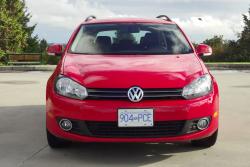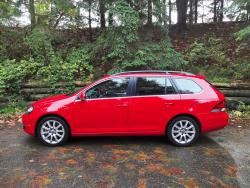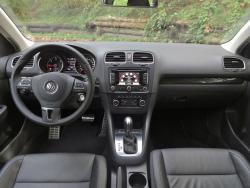When my brother and his wife were expecting their first child a couple of years ago, they ended up in an automotive quandary. Their car at the time was a bright yellow five-speed Mustang GT that they called “Sunny”, but they reasonably surmised it wouldn’t exactly make an ideal vehicle for a growing family.
So off they went car shopping, looking at all the various crossovers, sport utilities and minivans recommended to them by their friends with kids. For a couple of dipped-in-oil, city-dwelling motorheads (my sister-in-law might just be more car-crazy than my brother, and that’s saying something), it turned out to be a disappointing experience. The only vehicle they looked at that even halfway sparked their interest was the Mazda5, but my brother balked at what he perceived to be its awkward styling and lack of cool.
“Have you looked at the VW Golf Wagon?” I asked.
The thing is, for an urban couple interested in a compact, decent-handling family hauler that still retains a sporty, hip attitude, there’s really nothing else out there quite like the Volkswagen Golf Wagon. It has as much (or more) room inside than most compact crossovers, but it sits lower and handles with much of the taut competence of its famous hot-hatch sibling. Order the Golf Wagon up with the available TDI diesel engine and it offers phenomenal fuel economy to boot, comparable to a hybrid but with a far greater fun factor thanks to the diesel engine’s abundant low-end torque.
For 2015 Volkswagen is introducing the next-generation Mk7 Golf to the market, but while the hatchback arrived on our shores in late 2014, the Mk7 Golf SportWagen won’t be here until the first quarter of 2015. In the meantime, in typical Volkswagen fashion, the German maker is sending off the last of the Mk6 Golf Wagons here in Canada with an enticing Wolfsburg Edition trim option and a couple of previously unavailable colours (Toffee Brown Metallic and my test car’s Tornado Red). Why wait for the next-generation Golf SportWagen – which judging by the hatchback pricing looks like it’ll be slightly more expensive than the current Golf Wagon – when you can pick up a nicely loaded current-generation Wolfsburg Edition for somewhere between $29,070 (including the $1,395 destination fee) for the manual gasoline-powered car and $32,770 for the DSG automatic equipped TDI diesel? (For those swallowing hard at that number, the base five-speed gasoline-powered Trendline trim starts at $24,970 destination in.)
   2014 Volkswagen Golf Wagon Wolfsburg Edition TDI, dashboard. Click image to enlarge |
In Wolfsburg Edition trim, nicely loaded means the Golf Wagon comes with special 17-inch alloy wheels, leather upholstery, 10-speaker audio with satellite radio and navigation, panoramic sunroof, keyless entry, leather-wrapped steering wheel and gear knob, alloy pedals, dual-zone electronic climate control, fog lights, eight-way adjustable driver’s seat with power recline, and a few more things beside (this includes Wolfsburg badging that wasn’t actually installed on my test car, but which I later learned was likely hiding in the glovebox and would be installed by the dealer in a couple of minutes flat).
It’s a pretty nice bundle of gear at a price less than the Highline trim, but there are a few striking omissions: There’s no rear-view camera, no automatic headlights, and no USB audio input, all of which one might expect in a compact car in this price range (there is an iPod connector and an auxiliary plug, but I prefer running my tunes off an inexpensive USB thumb drive). I also found the touchscreen a little on the small side, which somewhat limits the usefulness of the navigation map, especially given the map’s rather chunky graphics. In a final nitpick, I found the row of blank switches ahead of the gearshift a little offputting–— it makes me wonder what equipment the car is missing.
In most other respects, the interior of the Golf Wagon is very well executed, if perhaps overly restrained. The dash is soft-touch, while the door uppers use quality-looking rigid plastic with a resilient outer skin (in contrast, the 2015 Golf five-door I drove recently improves things up front with soft-touch door uppers, but cheapens things in the back with hard plastic door uppers – I prefer the 2014’s even-handed compromise approach). The remainder of the plastics used in the interior are a good-looking and well-assembled blend of matte and textured surfaces, and the switch gear all has a high-end look and feel.
Up front I found the firm, supportive leather-upholstered seats to be a perfect fit for my 5’11” frame, with plenty of available leg room and decent elbow room. The back seat is a little more compact: I found it to have plenty of headroom and adequate leg room, but because the seat squab is quite low it meant there was no support under the front of my thighs. On the bright side, as my brother found out when he took a Golf Wagon for a test spin, the back seat fits most child seats with relative ease. For grown-up backseat passengers there’s a fold-down central armrest with a pair of built-in cupholders.
    2014 Volkswagen Golf Wagon Wolfsburg Edition TDI driver’s seat, gauges, navigation, centre stack. Click image to enlarge |
In the very back is the Golf Wagon’s interior party-piece, a 930 L cargo area that can expand to a voluminous 1,890 with rear seats folded down. To put this into perspective, the Jeep Cherokee has a lot less cargo space at 1,554 total L (841 litres with the rear seats up), the Ford Escape just about matches the Golf with 1,920 L of total space (971 behind the second row) and the minivan-like Mazda5 has only marginally more capacity at something like 2,500 L total cargo space and 1,250 L with the 3rd-row seats folded (Mazda is a bit cagey about releasing official cargo figures). To make the Golf Wagon’s cargo space even more useful there are hidden storage cubbies below the load floor, and an integrated adjustable divider you can use to secure your groceries and prevent them from playing roller-derby during the drive home.
Under the the hood, the Golf Wagon comes with a choice of either a 2.5L gasoline engine that delivers 170 horsepower and 177 lb-ft of torque to the front wheels, or my test car’s 2.0L turbocharged diesel engine that produces 140 horsepower and a healthy 236 lb-ft of torque. The new Golf hatchback’s 1.8T might be one of those reasons to wait for the Mk7 Wagon’s arrival….
My brother and sister-in-law were won over by the Golf Wagon, but elected to go for the gasoline version with a five-speed manual transmission (a conventional six-speed automatic is optional for an extra $1,400). All other things being equal, I prefer the TDI diesel myself, which comes paired with either a six-speed manual or six-speed DSG automatic (the TDI normally carries a $2,800 price premium but the Wolfsburg Edition whittles this down to $2,300; the DSG automatic adds a further $1,400 to the price).
    2014 Volkswagen Golf Wagon Wolfsburg Edition TDI seating, cargo area. Click image to enlarge |
Much has been made of the fuel economy advantages offered by the diesel, and I managed about 8.6 L/100 km in the city and 5.9 L/100 km on the highway while driving the the DSG-equipped Golf Wagon TDI, which really is quite good. Certainly if you rack up a lot of mileage you can make a strictly economic argument for the TDI, but it takes a while to see payback: Using the EPA’s five-cycle test, fuel consumption with the diesel works out to 7.8/5.6 L/100 km, while the gasoline-powered car uses 10.2/7.1 L/100 km under the same test regime. So if you take the average difference and say you’re burning 1.95 L less fuel per 100 km of mixed driving, then at the current near-parity price where I live of about $1.30 per litre for both diesel and gasoline, that means you’d pay off the Wolfsburg Edition TDI’s $2,300 price difference at something like the 90,700 km mark, assuming equal service costs (some owners report slightly higher post-warranty service costs for the diesels, making an extended warranty a tempting proposition; on the other hand, the TDIs tend to hold higher resale value).
The TDI offers more to appreciate than just excellent fuel economy, however: There’s also the splendid gobs of low-end torque offered up by the diesel, and the more advanced transmissions offered with the TDI (a six-speed instead of a five-speed manual, or a DSG instead of a conventional automatic). I’ve driven VW’s Golf Wagon TDI with both transmission options, and no matter which you choose, the engine’s torquey nature not only really suits the car, but makes driving genuinely engaging and enjoyable.
Choose the manual transmission and the diesel’s torque advantage means you can accelerate briskly from traffic lights without incurring a massive fuel-economy penalty, and it also means you’re almost never caught in too high a gear, making both city driving and highway passing a snap.
  2014 Volkswagen Golf Wagon Wolfsburg Edition TDI. Click image to enlarge |
Choose the DSG automatic, as fitted to my test car, and the diesel advantage brings out the best in Volkswagen’s direct, quick-shifting marvel of a gearbox: The DSG tends to seek the highest available gear in order to get the best possible fuel economy, and when hooked up to the company’s gasoline engines I find this tends to dull engine performance unless you select sport mode. But the TDI diesel pulls so mightily at low revs that no matter how quickly the DSG upshifts, there’s plenty of torque still available underfoot. It’s as if DSG stands for “Diesel Synchronized Gearbox” instead of “Direct Shift Gearbox,” and while Sport mode is still available, the diesel’s torque makes it mostly superfluous.
Whichever engine you choose, Volkswagen’s Golf Wagon competes indirectly against a diverse array of rivals, encompassing compact hatchbacks such as the Hyundai Elantra GT and Mazda3 Sport, compact crossovers like the Honda CR-V and Ford Escape, and tall wagons (or is that small minivans?) like the Kia Rondo and Mazda5. Select the TDI diesel and the Golf Wagon becomes a serious contender against hybrids such as Toyota’s Prius V and Ford’s C-Max. Ultimately, however, Volkswagen’s little wagon has no real direct competitors in its price bracket: compact hatchbacks don’t have its hauling capacity, crossovers don’t handle near as well, tall wagons don’t have its sense of style, and hybrids can’t match its driving engagement. For those who value all these traits, that makes the Golf Wagon a clear winner.
|
Manufacturer’s Website: Volkswagen Canada Photo Gallery: Crash Test Results: |
Pricing: 2014 Volkswagen Golf Wagon Wolfsburg Edition TDI
Base Price: $31,375
Options: None
Freight: $1,395
A/C tax: $100
Price as tested: $32,870
Competitors:
Ford C-Max
Ford Escape
Honda CR-V
Hyundai Elantra GT
Kia Rondo
Mazda3 Sport
Mazda5
Toyota Prius V
















